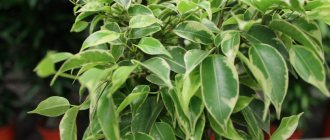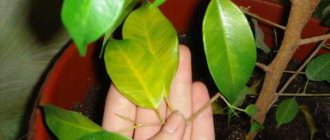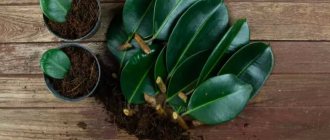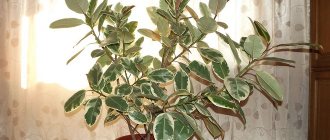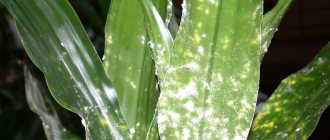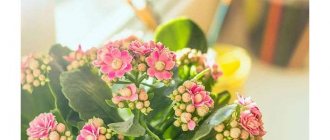How to choose in a store
Most often, ficuses come into our homes from flower shops or from hand, so it is important to choose a healthy plant and not run into an unscrupulous seller.
A few rules to choose from:
- The larger the specimen, the worse it adapts to new conditions; it may shed its leaves or begin to dry out. The process of addiction sometimes lasts up to 6 months;
- Look in the pot's drainage hole - dark brown or black roots are a bad sign;
- A little trick - iron the flower against the foliage or shake the bush. If at least a couple of leaves have fallen, then it is better to choose something else;
- Ficuses freshly delivered to the store take root best, as they do not yet have time to adapt and get used to the changed conditions;
- It is recommended to make a purchase in the spring so that the new pet has time to grow stronger and greener over the summer before daylight hours begin to wane.
Note! The first two weeks after purchase and transplantation, the flower may wilt - this is normal; proper care will return it to a healthy appearance.
The price of Triangularis is set depending on the size of the plant. The average cost for a rooted cutting with several leaves is 300-350 rubles; you can buy an adult shrub for a price of 800 rubles. The most popular are specimens with variegation, that is, with spotted leaves.
Purchased flowers must be kept in quarantine for 2-3 weeks to make sure there are no diseases and to prevent infection of other plants.
Description of ficus
Triangularis is characterized by compactness and interesting triangular-shaped leaves attached to the base of the trunk.
The length of the leaves is up to 6-8 cm, the surface is glossy, leathery, the color depends on the variety and can be dark green, solid or spotted with grayish veins.
Some gardeners romantically compare the shape of leaf blades to hearts.
Proper care allows you to achieve abundant flowering from an early age. Representatives of this species form brown, green or yellow small round inflorescences called syconnia, reminiscent of berries.
The main feature of the plant is its rapid growth, which is 11-16 cm per year.
The species includes the following popular varieties, differing in color:
- Variegata is a plant with leaves of an unusual variegated color in light shades. Very rare in home floriculture.
- Natalie Trinova (Trinova) - a common variety with a uniform bright green crown;
- White Margin - has foliage with white variegation and a characteristic beige border along the edges.
Origin of the flower
Ficus triangularis, or Ficus triangularis, comes from the mulberry family. In reference books this plant can be found under the name Ficus triangularis. According to its characteristics, it is very different from its relatives. The flower is an evergreen shrub with small and glossy leaves.
Triangular ficus has unusual leaves, their shape resembles circles that are inside a triangle, while creating an interesting shape. The maximum length of the leaves is 6 cm. The leaf blade is very thin, the veins are always gray with a slightly greenish tint. The main characteristic of the species is that it can grow more than 11 cm in a year.
Home conditions are excellent for bush fertility. Sometimes representatives of this species are found with bright spots on the leaves.
In nature, Ficus Triangularis is found in the warm climate of Africa. It is very difficult to recognize, since in the wild it grows up to at least 30 m, while at home such a ficus can grow to a maximum of 1 m.
Growing conditions
Temperature
Protect the plant from drafts
This African shrub loves both cool and warm. The optimal temperature in summer is 20-25⁰C, in winter - 16-17⁰C (you shouldn’t go lower).
It is unacceptable to place the pot in cold rooms, in drafts or in conditions of constant temperature changes. In summer, the flower can be exposed to fresh air.
Humidity
The plant requires regular spraying with soft (to prevent limescale stains on the leaves) water at room temperature and sufficient air humidity.
To maintain the necessary microclimate, you can place a humidifier in the room or place the pot on a tray with wet expanded clay, which will help support the ficus in winter, when dry air comes from the radiators.
It is better to place the flower away from heating devices (more than 2 m), otherwise the roots and leaves will dry out.
Lighting
Ficus Triangularis, despite its tropical origin, is shade-tolerant and grows well even on northern windows.
But direct sunlight must be avoided - they cause burns and overheating of the leaves, which are difficult to heal, but bright, diffused light is still preferable.
In the warm season, it is recommended to move the pot deeper into the room, into the shade, or provide diffused lighting. The bush does not like changing places.
Elastica (rubber)
Perhaps the most famous variety of ficus. Even if you are not at all interested in indoor plants, you have probably seen the rubber-bearing ficus somewhere - it is incredibly common, and is a huge success among those who want to green up their apartment.
There is a belief that this particular type of ficus brings family happiness. Whether you believe in omens or not is up to you to decide - but the beauty of this ficus lies not only in its mystical meaning.
Rubber-bearing ficus has many varieties. As a rule, they are bred artificially to make the plant more compact.
Transfer rules
Transplantation after purchase is carried out no earlier than 14 days later, so that the plant has time to adapt.
As they grow, transplantation is also carried out in the spring. The pot should be a couple of centimeters larger than the old one.
For ficuses, you can use special soil sold in the store, or mix equal parts of turf, sand, peat or leaf soil.
Soil dug up from gardens or parks requires disinfection with boiling water or heating in the oven to avoid the development of pathogens and insects.
A drainage layer is first placed in the pot, which is covered with sand. Then the soil is poured and the bush is moved. After transplanting, the flower needs to be watered.
Young ficus trees are replanted annually, and after 5 years - once every two years.
Soil category
The soil should be loose and light in structure. Also, the soil should allow air to pass well to the root system and saturate it with useful microminerals that are necessary for growth. You can purchase ready-made soil at a flower shop; it is perfect for ficus. Before planting in the ground, you need to add a small amount of sand and drainage crumbs. You can also make the soil yourself. There are 2 options.
- Soil from leaf and turf soil, everything should be in equal quantities. You can also add coal and a little sand.
- Mix peat soil, leaf soil, turf soil and sand. It is also necessary to adhere to the acidity of the soil: it should not be higher than 6.5%.
There must be drainage soil at the bottom of the pot; it can handle a large amount of water and help the flower and its root system develop correctly and on time. At home, the plant will delight you with its flowering every day. The flowers of this species are small, round in shape, brown in color and look like small berries. During warm periods they may fall off.
It is best to replant ficus in February or at the end of March. Flowers that are no more than 5 years old should be replanted every year, but it is advisable to replant older plants once every 2 years.
If the plant pot is larger than 30 cm, you can simply replace the first layers of soil with a new type of soil. But this is only if flower transplantation is impossible. In order to maintain a good appearance of the plant, constant and regular pruning is necessary, as well as the formation of the crown of the plant: this will also have a good effect on the health of the flower. To properly create a trunk, all side shoots on the main stem are removed until everything reaches the required height. Then the top of the stem must be attached. New shoots will very quickly begin to appear from the axillary buds.
In subsequent years, shoots that have grown must be cut off again and not allowed to grow around the crown. Also, we must not forget to remove branches that look weak, since the plant can send a lot of strength and vitamins into it so that they are restored, while other branches will not receive the necessary minerals in sufficient quantities. If the branches suddenly begin to bleed, they must be treated to prevent infection from getting inside.
How to care
Watering
Watering should be regular, but not frequent. Watering should be done with settled water at room temperature, avoiding hot or cold, which can cause stress to the root system.
In summer, ficus is watered 1-2 times a week, in winter - once every 7-10 days.
Overmoistening causes root rot, so any water that leaks into the pan must be drained.
To clarify the need for watering, you can check the pot by weight or feel the soil - it should be dry 1-2 cm deep.
Feeding
Ficus does not like stagnant moisture
Fertilizers are applied during the period of active growth - from the beginning of spring to autumn, 2 times a month.
They use liquid fertilizers with alternating organic and mineral compositions: once organic, the next - an inorganic mixture.
If necessary, you can organize additional meals in winter - once every 20 days (for example, during rehabilitation after illness).
Reproduction
Reproduction is carried out in the following ways:
Cuttings are the most popular and simplest method using shoots 15-18 cm long, cut at an acute angle. It is not advisable to break off shoots or use scissors. The cuttings must have at least three pairs of leaves.
In the first couple of hours, the cutting is placed in water, and then the cut is dried to avoid the release of milky juice, which can inhibit root growth.
To root the apical branches, they are placed in a moist nutrient mixture of fertile layer and sand or in water with activated carbon.
When germinating in a substrate, the shoots are covered with film or a plastic bottle. Once a day, open slightly to allow access to fresh air - at this time the sprout is moistened with a spray bottle.
In such a mini-greenhouse, adventitious roots form within 3-4 weeks. This will be indicated by the appearance of young leaves, after which the grown plant is planted in an adult pot.
Air layering - several leaves are cut off on a long shoot of the mother plant and two cuts are made in this place at a distance of up to 3 cm.
In the resulting gap, the bark is peeled off, the open “wound” is wrapped in damp sphagnum and covered with film. This is where roots will form. When they are visible, the film is removed and the plant is planted.
Seeds - ficus bears fruit abundantly, so you can sow throughout the year, but it is better from February to April, which favors the growth of young plants.
- The seeds are poured evenly into the soil for planting ficuses, poured 3-5 cm thick.
- The crops are lightly sprinkled and the soil is well moistened.
- The container is covered with film or glass and left in this form for 2-8 weeks until sprouts appear.
- Plantings are ventilated every 3-4 days.
It is best to propagate in the spring at a room temperature of 24-32⁰C.
Popular types
Ficus ali: 4 main types and care for them
There are several varieties of ficus that have become especially popular due to their appearance, easy care and fairly fast growth rate. It is these types of crops that are most often found on sale in the form of grown plants and even seeds.
Ficus benjamina
A tree-like variety of the crop, which is most widespread among flower growers. Outwardly it resembles a dwarf tree, but in comfortable conditions it can grow up to 2 m in height. Forms beautiful drooping branches on which there are oval or ovoid leaves. Depending on the variety, they may have different shades and textures. Ficus benjamina with wavy leaf plates with variegated colors are especially valued.
Despite its great popularity, the plant needs special care. The tree does not like to change its location and also likes constant moderate watering. Often, gardeners plant several plants side by side to achieve intertwining of aerial roots as they grow.
Rubber-bearing (Elastica)
Until recently, this type of ficus was the most popular for growing in an apartment. He is most often depicted in pictures and photos of this culture. The plant got its name because the plant sap contains rubber, which is often used to make rubber.
Can grow to impressive sizes. The powerful trunk reaches 2 meters in height; with proper pruning, the shoots branch quite strongly. A distinctive feature is the wide glossy leaves of a dark green hue, but variegated varieties have also been bred. Gradually, the lower parts of the plant fall off, leaving the trunk exposed.
With high humidity, aerial roots form on the plant, which is used to create decorative compositions. If you create comfortable conditions, up to 1 new leaf is formed during the growing season. All parts of the plant are capable of purifying oxygen from harmful toxins.
Lyre-shaped
This type of ficus got its name because of its resemblance to a musical instrument. Depending on the variety, it can be represented by a dwarf, medium-sized or rather tall tree up to 1.5 m high. The dark green foliage has a decorative wavy shape and can grow up to 50 cm in length, so when growing a plant it is advisable to choose the right place.
It does not form aerial roots at home, but is valued for its high growth rate. The plant is very light-loving; insufficient lighting reduces the attractiveness of leaves and shoots
It has a pronounced dormant period, during which it is important to provide the plant with cool conditions in the range from 10 to 15 o C
Deltoid or variegated
This species is native to Southeast Asia. The species is named after the Greek letter delta because the leaves are triangular in shape. In adulthood, it is represented by a voluminous bush with strong branching and many aerial roots.
The deltoid ficus is distinguished by heterophylly - leaves of different shapes and colors can form on one plant and even shoots. The bark of the trunk is colored a beautiful gray-brown shade, and the leaf blades usually have a glossy color and a slight convexity. When growing, regular shaping is required to maintain the decorative appearance of the plant.
Ficus Binnedica (Ali)
The evergreen ficus grows wild in South Asia. The plant is represented by a low tree with a decorative rough trunk. The leaves are drooping and have a traditional lanceolate shape. In adulthood, they grow up to 30 cm in length, while their width is only 2 cm. Depending on the variety, they can have different colors; leaf blades with a white border and a spotted light green pattern are especially popular.
Ficus Ali is a heat-loving plant, sensitive to the effects of cold and drafts. There is no pronounced dormancy, so it is recommended to fertilize in winter. Suitable for shaping a bonsai tree, but proper shaping is required from the first year of growth.
Diseases and pests
Shrub disease is expressed in the appearance of spots on the trunk and crown, stunted shoots, wilting or drying of leaves, and rotting of roots.
- Insect damage (aphids, scale insects, thrips, spider mites) - for treatment, the bush is washed with running water and soapy water and sprayed with insecticides;
- Fungus (powdery mildew, gray rot) - multiplies when waterlogged. The affected parts are removed, and the remaining parts are treated with a fungicide;
- Violation of maintenance conditions - to restore the health of the flower, it is enough to arrange care.
For prevention, it is enough to simply follow the rules of care and keep newly acquired plants in quarantine.
